Modern physics continues to view space as a container in which the material universe is constructed, and time merely as an 'inconvenience', being no more than a linear measurement of change, and not considered to be part of the constructs of space.
The Reciprocal System altered this view by making space and time aspects of motion, and motion as both the container, and containee, of the constructs of the universe.
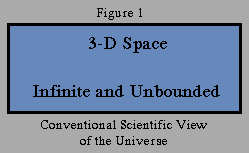 |
Modern physics still considers all manifestation to be composed of 3-D coordinate space, which is both infinite and unbounded, as shown in Figure 1. There is nothing else to the universe, except what is manifest in 3-D space. |
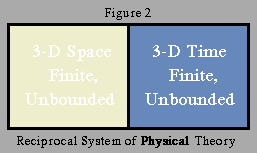 |
When Larson discovered the reciprocal relationship between space and time, and that all units are discrete, an important step was taken. Space and time, composing the physical universe, became inseparable, isotropic, and finite. An entirely new sector of the universe opened up, the Cosmic sector, with its three dimensions of coordinate time. Larson's physical universe, as shown in Figure 2, is composed of two 3-D sectors of space and time—both finite, yet unbounded. Infinity, with all its inherent mathematical problems, disappeared from the constructs of the physical universe. |
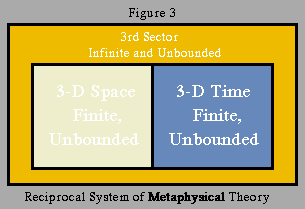 |
Having described the properties of space and time in a finite context, Larson found other phenomena in mankind's experience that continued to remain a mystery. To account for these phenomena, he postulated a "3rd Sector", totally non-physical, that exists outside both space and time, yet still interacts with the physical universe. It is in this 3rd Sector that infinity makes its return to the Reciprocal System. |
By examining these evolving views of the universe, we can conclude that as a sector of the universe is explored and its properties determined, it makes a transition from being infinite, to being finite. This can be seen in the original view of 3-D space being infinite, then as quantum phenomena were investigated, space moved towards the finite, with the quantum region becoming non-local, and infinite. The discovery of 3-D time region as the region of quantum mechanics altered the infinite quantum realm back to the finite realm of the time region, and infinity became assigned to the only place that remained in the context of the theory—that which is non-physical—the 3rd Sector. In other words, you will always find an infinity where you find an area that is not properly understood, unexplored, or just plain 'unknown'.
This is fairly obvious in the postulates of Larson's 3rd Sector, which vary greatly from the postulates of the first 2 sectors. However, if we were to continue with Larson's initial premise that the universe is composed solely of motion, and the universe is also consistent, it is possible to theorize the next logical step in the evolutionary view of space, time, and beyond.
First off, the concept of motion must be taken as a more generalized concept—that of motion being an inverse relationship between two aspects regardless of what the aspects are named. Physical motion can then be defined as having the aspects of space and time; metaphysical motion can be defined as having the aspects of the physical and the non-physical.
Secondly, the process of complexity of motion must be considered. In the physical universe, motion starts off as linear vibration. To this, a 1-dimensional rotation is added to produce the sub-atomic particles, then a 2-dimensional rotation forming the atoms. To either rotation, a rotational vibration can be added to produce magnetic and isotopic effects. Because the system is limited to three dimensions, no other types of motion can be added to a compound motion, though the magnitude of existing motions can increase. But this, too, has a limit (atomic number 117). For complexification to continue, another type of motion must occur.
Rotation is essentially a reciprocal relationship between two axes. If you examine a point moving around the circumference of a circle, as the absolute magnitude of one axis diminishes, the other increases. Therefore, rotation deals with complexification of coordinate dimensions. Since we have used all possibilities of coordinate dimension, the next type of motion that can occur is the scalar equivalent of rotation—recursion—motion defined with the aspects of the physical and the non-physical.
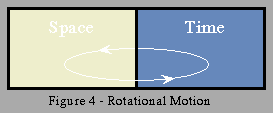 |
Physical rotation is shown in Figure 4, with the aspects of space and time. |
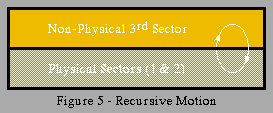 |
Figure 5 shows inter-sector recursive motion, with its aspects of the physical and the non-physical. Note that both Sectors 1 and 2 comprise the physical aspect of this type of motion, and as such, recursive motion functions to link the physical-type motions of the Material and Cosmic sectors into a single, more complex motion. In other words, recursion allows a Material structure to link to a Cosmic structure—thru motion—and forms a new type of unit, which Larson describes as a Life Unit. |
This also infers that the non-physical sector has the same attributes and characteristics of the physical sector, just as time has the same attributes and characteristics of space.
To a researcher unfamiliar with the dimensional aspects of time, the time region appears non-local, and hence infinite. The same applies to the non-physical region of a life unit. It will also appear as non-local to the physical, and appear to be infinite.
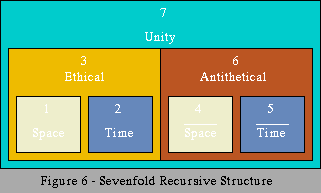 |
By the identification of recursive motion in the evolving views of space and time, we can now determine what the higher-level structures look like beyond the 3rd sector. Most theologies and philosophies state that there is a 7-fold structure behind all manifestation. If we assume this to be correct, the application of recursion to the existing metaphysical aspects of the Reciprocal System yields this structure. |
It is from this point that a detailed investigation of the 3rd sector, as a finite, discrete system of motion can begin, and the attributes of other sectors separated out, quantized, and identified, producing a true Universe of Motion. No additional postulates should be required, and a complete metaphysical universe can be theorized using the same techniques that worked so well for the physical universe of the Reciprocal System.
Reciprocity XXVI, #2 (Summer, 1997), p. 14.
